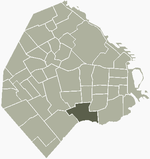Nueva Pompeya
| Nueva Pompeya | |
|---|---|
| Barrio | |

Alsina Bridge
|
|
 Location of Nueva Pompeya within Buenos Aires |
|
| Country |
|
| Autonomous City | Buenos Aires |
| Comuna | C4 |
| Important sites |
|
| Area | |
| • Total | 6.1 km2 (2.4 sq mi) |
| Population | |
| • Total | 63,276 |
| • Density | 10,000/km2 (27,000/sq mi) |
| Time zone | ART (UTC-3) |
Nueva Pompeya (Spanish for New Pompei) is a neighbourhood in the city of Buenos Aires, Argentina. Located in the South side, it has long been one of the city's proletarian districts steeped in the tradition of tango and one where many of the first tangos were written and performed.
A neighborhood local, the legendary tango composer Homero Manzi, set a very popular tango (Sur) in Nueva Pompeya, describing a melancholy landscape (“Pompeya and beyond the flood”) that, even today, defines much of the district's physionomy.
Nueva Pompeya was given its name by the faithful of the Virgin of the Rosary of Pompeya, raised in 1900 by Capuchin monks. Until then, it was often referred to as the "district of the Frogs." The term “frog”, in the Buenos Aires vernacular, refers to the "street-wise" man, and, indeed, many of Nueva Pompeya's youth are thought of this way to the present day.
Nueva Pompeya was largely built on the alluvial plain north of the Riachuelo and, at the time, it was subject to frequent flooding. It was consequently thinly populated, and was notorious for its poverty and high crime rate.
Until the 1930s, when industries began setting up in the area, most locals worked in the large slaughterhouse in neighboring Parque Patricios. Sáenz Avenue, which leads through Nueva Pompeya, is still sometimes referred to as "the street of bones", for the many cattle that died on their way to the slaughterhouse, early in the twentieth century.
The area was also well known for its many pulperías, seedy saloons frequented by cutlers, carriers and guitarists. Two are still preserved as museums: La Blanqueada and the Maria Adelia Pulperia, which had a patio so large that it served as a field hospital during the 1880 conflict between the Nation and secessionist factions in Buenos Aires.
Over the course of the twentieth century the district developed its present urban aspect. In 1938 a bridge adorned with arcs and columns of rubblework in neo-colonial style was opened on the Matanza river. A district landmark, it was first called Valentín Alsina Bridge and renamed after de facto President José Félix Uriburu following his death in 1932. The original name was restored in 2002. The district's residential areas are mostly one-story rowhouses.
...
Wikipedia
